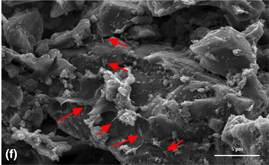Crossref Citations
This article has been cited by the following publications. This list is generated based on data provided by
Crossref.
Du, Zhipo
Wang, Cunyang
Zhang, Ruihong
Wang, Xiumei
and
Li, Xiaoming
2020.
<p>Applications of Graphene and Its Derivatives in Bone Repair: Advantages for Promoting Bone Formation and Providing Real-Time Detection, Challenges and Future Prospects</p>.
International Journal of Nanomedicine,
Vol. Volume 15,
Issue. ,
p.
7523.
Ege, Duygu
2021.
Action Mechanisms of Curcumin in Alzheimer’s Disease and Its Brain Targeted Delivery.
Materials,
Vol. 14,
Issue. 12,
p.
3332.
Mocanu, Aura-Cătălina
Miculescu, Florin
Stan, George E.
Ciocoiu, Robert-Cătălin
Corobea, Mihai Cosmin
Miculescu, Marian
and
Ciocan, Lucian Toma
2021.
Preliminary Studies on Graphene-Reinforced 3D Products Obtained by the One-Stage Sacrificial Template Method for Bone Reconstruction Applications.
Journal of Functional Biomaterials,
Vol. 12,
Issue. 1,
p.
13.
Bonetti, Lorenzo
De Nardo, Luigi
and
Farè, Silvia
2021.
Thermo-Responsive Methylcellulose Hydrogels: From Design to Applications as Smart Biomaterials.
Tissue Engineering Part B: Reviews,
Vol. 27,
Issue. 5,
p.
486.
Guo, Jason L.
Kim, Yu Seon
Koons, Gerry L.
Lam, Johnny
Navara, Adam M.
Barrios, Sergio
Xie, Virginia Y.
Watson, Emma
Smith, Brandon T.
Pearce, Hannah A.
Orchard, Elysse A.
van den Beucken, Jeroen J.J.P.
Jansen, John A.
Wong, Mark E.
and
Mikos, Antonios G.
2021.
Bilayered, peptide-biofunctionalized hydrogels for in vivo osteochondral tissue repair.
Acta Biomaterialia,
Vol. 128,
Issue. ,
p.
120.
Motameni, Ali
Alshemary, Ammar Z.
Dalgic, Ali Deniz
Keskin, Dilek
and
Evis, Zafer
2022.
Graphene oxide reinforced doped dicalcium phosphate bone cements for bone tissue regenerations.
Journal of the Australian Ceramic Society,
Vol. 58,
Issue. 5,
p.
1633.
Li, Xiao-Dan
Yan, Da-Wei
Ren, Hao-Hao
Zhang, Qi-Yi
and
Yan, Yong-Gang
2023.
Fabricating biodegradable calcium phosphate/calcium sulfate cement reinforced with cellulose:in vitroandin vivostudies.
Journal of Materials Chemistry B,
Vol. 11,
Issue. 2,
p.
303.
Demir-Oğuz, Öznur
Boccaccini, Aldo R.
and
Loca, Dagnija
2023.
Injectable bone cements: What benefits the combination of calcium phosphates and bioactive glasses could bring?.
Bioactive Materials,
Vol. 19,
Issue. ,
p.
217.
Handa, Saksham
Dan, Siddhartha
and
Sah, Mahesh Kumar
2023.
Graphene and its derivatives as support system ingredient for bone fracture repair.
Graphene and 2D Materials,
Vol. 8,
Issue. 3-4,
p.
43.
Khodabandehloo, Amir Hossein
Pourmadadi, Mehrab
Shamsabadipour, Amin
Langari, Hadis
Manicum, Amanda‐Lee
Rahdar, Abbas
and
Baino, Francesco
2023.
Two‐dimensional materials for bone‐tissue engineering.
Journal of the American Ceramic Society,
Vol. 106,
Issue. 9,
p.
5111.
Mishchenko, Oleg
Yanovska, Anna
Kosinov, Oleksii
Maksymov, Denys
Moskalenko, Roman
Ramanavicius, Arunas
and
Pogorielov, Maksym
2023.
Synthetic Calcium–Phosphate Materials for Bone Grafting.
Polymers,
Vol. 15,
Issue. 18,
p.
3822.
Ye, Minxuan
Zhou, Changren
and
Yu, Tao
2024.
Highly dense calcium phosphate ceramics prepared by self-hydration with hollow silicon calcium additives.
Ceramics International,
Vol. 50,
Issue. 2,
p.
3260.
Bonetti, Lorenzo
Borsacchi, Silvia
Soriente, Alessandra
Boccali, Alberto
Calucci, Lucia
Raucci, Maria Grazia
and
Altomare, Lina
2024.
Injectable in situ gelling methylcellulose-based hydrogels for bone tissue regeneration.
Journal of Materials Chemistry B,
Vol. 12,
Issue. 18,
p.
4427.
Ege, Duygu
and
Kamali, Ali Reza
2024.
XGB Modeling Reveals Improvement of Compressive Strength of Cement-Based Composites with Addition of HPMC and Chitosan.
Materials,
Vol. 17,
Issue. 2,
p.
374.
Fernandes, H.R.
Kannan, S.
Alam, M.
Stan, G.E.
Popa, A.C.
Buczyński, R.
Gołębiewski, P.
and
Ferreira, J.M.F.
2024.
Two decades of continuous progresses and breakthroughs in the field of bioactive ceramics and glasses driven by CICECO-hub scientists.
Bioactive Materials,
Vol. 40,
Issue. ,
p.
104.
